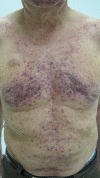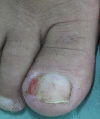Chemotherapy and skin reactions
- PMID: 22640460
- PMCID: PMC3583303
- DOI: 10.1186/1756-9966-31-50
Chemotherapy and skin reactions
Abstract
Background: New chemotherapic agents and new protocols in oncology have led to an increasing survival rate in patients affected by tumors. However, this increased use has been accompanied by a growth in the incidence of cutaneous side effects and a worsening of patients' quality of life. Appropriate management of skin toxicity associated with chemotherapic agents is therefore necessary for suitable drug administration and to improve quality of life and clinical outcomes.
Methods: We have clinically examined 100 patients affected by cancer, determining type, frequency, treatment, and evolution of side effects related to chemotherapy.
Results: The prevalent cutaneous side effects in patients undergoing chemotherapy are skin rash, xerosis, pruritus, paronychia, hair abnormality, and mucositis. The clinical cases are reported in detail.
Conclusion: Oncological therapies have become more selective and have low systemic toxicity because of their high specificity, but cutaneous side effects are common and may worsen the quality of life of these patients.
Figures
References
-
- Wagner LI, Lacouture ME. Dermatologic toxicities associated with EGFR inhibitors: the clinical psychologist’s perspective. Impact on health-related quality of life and implications for clinical management of psychological sequelae. Oncology (Williston Park) 2007;21:34–36. - PubMed
MeSH terms
Substances
LinkOut - more resources
Full Text Sources
Other Literature Sources
Medical





